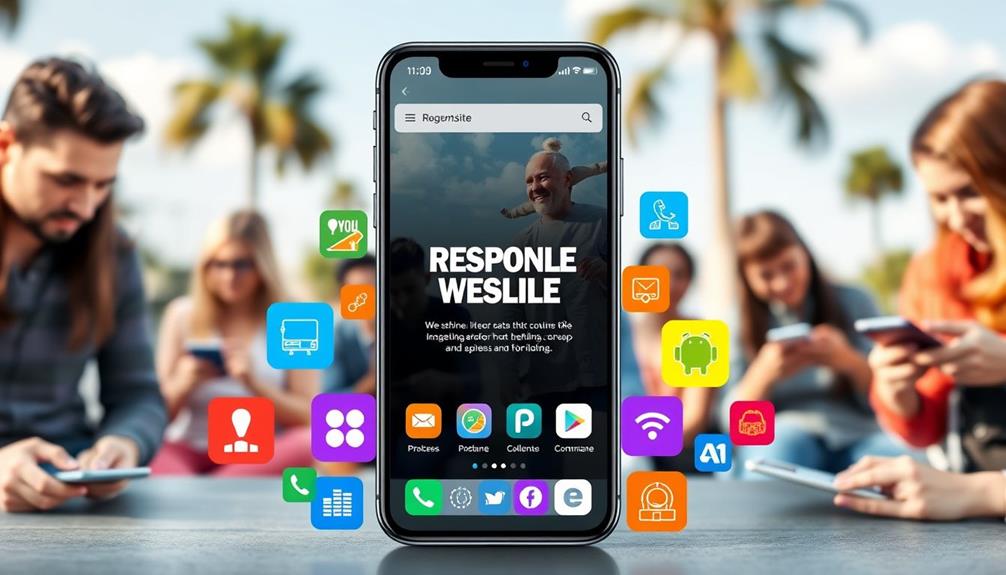Mobile-first indexing is vital to guarantee your site thrives in today's smartphone era. Google prioritizes the mobile version of your site for indexing and ranking, so it's important to have a mobile-friendly design. Make your content easily navigable and confirm quick load times—aim for under three seconds to keep users engaged. Consider using responsive design, optimizing images, and checking structured data for better SEO. If you don't optimize for mobile, you risk losing valuable traffic and potential customers. There's more to explore on optimizing your site effectively for mobile-first indexing.
Key Takeaways
- Google prioritizes mobile versions of websites for indexing, making mobile optimization essential for higher search rankings.
- Ensure your site loads in 3 seconds or less to meet mobile user expectations and improve conversion rates.
- Implement responsive design to provide a seamless user experience across both mobile and desktop devices.
- Regularly test mobile site performance using tools like Google PageSpeed Insights to identify and fix speed issues.
- Maintain consistent content between mobile and desktop versions to enhance SEO and user experience.
Understanding Mobile-First Indexing
Mobile-first indexing is a game-changer for how Google evaluates websites, focusing primarily on their mobile versions.
As mobile usage has surpassed desktop usage, Google has shifted to prioritize the mobile version of websites for indexing and ranking. This means that when Google's bots crawl your site, they'll look at the mobile content first. If your site isn't mobile-friendly, you're risking lower search engine rankings.
Furthermore, guaranteeing a mobile-optimized site aligns with balancing innovation and privacy rights as users expect secure and efficient browsing experiences.
To maintain visibility in search results, it's vital to confirm your website is optimized for mobile. Websites that don't meet mobile-first standards will see a decline in their search rankings, as only the mobile content will be considered.
With statistics showing that over 50% of global web traffic comes from mobile devices, having a mobile-friendly website isn't just an option; it's a necessity.
Importance of Mobile Optimization

Mobile optimization isn't just a nice-to-have; it's vital for your website's ranking and user engagement.
With the rise of mobile users, search engines are increasingly prioritizing mobile-friendly sites in their algorithms, making it imperative to adapt to this shift.
If your site isn't mobile-friendly, you risk dropping in search rankings and losing potential customers.
By prioritizing mobile optimization, you'll create a better experience for users and improve your visibility in search results.
Implementing keyword clustering and topic clustering can also enhance your site's relevance and discoverability.
Ranking Impact
With over 50% of global web traffic coming from mobile devices, optimizing your site for mobile is more vital than ever.
Mobile-first indexing means Google prioritizes the mobile version of your website for indexing and ranking, making mobile optimization essential for maintaining your visibility in search results. If your site isn't mobile-friendly, you risk dropping in rankings, as only visible mobile content is considered in Google's indexing algorithm. Incorporating stress management techniques into your content strategy can enhance user experience and engagement on mobile platforms.
A BrightEdge study shows that 79% of searches exhibit differing ranks between mobile and desktop, highlighting the significant ranking impact of mobile optimization. If you want to stay competitive, you need to adopt effective SEO strategies that prioritize the mobile user experience.
Additionally, page speed plays a vital role—just a 1-second delay in load time can lead to a 7% reduction in conversions.
Research indicates that 93% of mobile researchers are likely to make a purchase, emphasizing that your mobile optimization directly affects conversion rates and revenue.
In today's digital landscape, ensuring your site is optimized for mobile isn't just a good practice; it's a necessity for success.
User Engagement
As more users turn to their smartphones for browsing, optimizing your website for mobile becomes vital for boosting user engagement. Mobile traffic now makes up an average of 62% of total website visits, so enhancing the mobile user experience is essential.
A seamless mobile experience can considerably impact your engagement metrics; in fact, 93% of mobile researchers are likely to make a purchase after visiting a brand's site multiple times. Additionally, reflecting on the eco-friendly aspects of energy solutions, like geothermal energy, can also resonate with environmentally conscious consumers.
Websites that aren't optimized for mobile often face higher bounce rates and lower session durations, which negatively affect user engagement and conversion rates. One important factor to reflect on is page load speed—just a 1-second delay can reduce mobile conversions by 7%.
Moreover, Google prioritizes mobile-friendly websites in its search rankings, meaning that if your site isn't optimized, you risk losing visibility in this mobile-first indexing era.
Without proper mobile optimization, you're likely to see decreased user engagement as potential customers struggle to navigate your site. By focusing on these aspects, you can enhance user satisfaction and drive conversions effectively.
Impact on Consumer Behavior

The rapid shift to mobile-first indexing has reshaped how consumers behave online, making it imperative for brands to adapt. With mobile traffic now averaging 62% of total website visits, it's clear that mobile users are relying more on their devices for brand engagement and research.
This trend greatly influences consumer buying decisions; research shows that 93% of mobile users conducting product research are likely to make a purchase. Additionally, brands that prioritize a clean and efficient user experience, similar to air purifiers' impact on indoor quality, can further enhance engagement and conversion rates.
As a brand, you need to recognize that mobile influences over 40% of revenue in leading B2B companies. This underscores the crucial role mobile plays in driving sales.
Furthermore, mobile users typically visit a brand's site six times before making a purchase, highlighting the importance of a strong mobile presence to facilitate repeated engagement.
With mobile-first indexing, consumers are more likely to encounter mobile-optimized sites in search results. This not only affects your brand's visibility but also builds consumer trust.
To stay competitive, it's essential to verify your website is mobile-friendly, as a well-optimized site can greatly enhance user experience and ultimately boost your sales.
Adapt now to thrive in this mobile-driven landscape!
Page Load Speed Considerations

To thrive in a mobile-first world, page load speed is an essential consideration that can't be overlooked. Mobile users expect your website to load in 3 seconds or less; otherwise, you risk losing them. In fact, a mere 1-second delay in page load time can lead to a staggering 7% decrease in conversions. This makes optimizing your site not just a nice-to-have, but a necessity for success.
Additionally, guaranteeing your site is efficient is similar to providing a reliable service, much like a reputable home cleaning service that meets customer expectations.
Here are some emotional impacts of poor page load speed:
- Frustration when waiting for a slow site to load
- Disappointment leading to lost trust in your brand
- Missed opportunities for connecting with potential customers
To enhance user experience, leverage tools like Google PageSpeed Insights. These tools offer valuable insights and recommendations for improving your page load speed.
Focus on strategies like optimizing images and minimizing HTTP requests, which are key to mobile optimization. Remember, every second counts when it comes to keeping your mobile users engaged.
Prioritizing page load speed not only boosts your search visibility but also elevates the overall experience for your audience. So, take action now and guarantee your site is ready for the mobile-first era!
Best Practices for Mobile-Friendliness

To guarantee your site is mobile-friendly, start by implementing responsive design that adjusts seamlessly to different screen sizes.
This approach is essential as it not only enhances the user experience but also aligns with WordPress offers user-friendly interface for managing content across devices.
You should also optimize media content and enhance page load speed, as these factors greatly impact user experience and search rankings.
Responsive Design Importance
More than 62% of total website traffic now comes from mobile devices, making responsive design an essential element for any online presence. By guaranteeing your website automatically adjusts its layout and content, you can greatly enhance user experience across various devices. Engaging content, such as fun personality quizzes for kids, can further attract and retain visitors on mobile platforms.
Google favors responsive design too, as it streamlines indexing with a single URL and consistent HTML, positively impacting your SEO strategy.
Consider these points when implementing responsive design:
- Boost user satisfaction by providing a seamless experience, whether on a phone or desktop.
- Reduce bounce rates; mobile users expect the same smooth navigation they enjoy on larger screens.
- Enhance mobile performance, improving load times and site efficiency, critical for retaining visitors.
Implementing responsive design isn't just a trend; it's a necessity in today's mobile-centric digital landscape.
By utilizing tools like Google Search Console, you can monitor your site's performance and guarantee it meets the demands of your audience.
Prioritize responsive design today, and watch your engagement and conversion rates soar!
Optimize Media Content
Optimizing media content is vital for guaranteeing a smooth mobile experience. As mobile users expect pages to load within 3 seconds or less, it's imperative to use appropriately sized and compressed image files. Descriptive alt text not only aids accessibility but also boosts your SEO, helping search engines index your media effectively.
When it comes to videos, verify you're using formats that allow for adaptive streaming. This approach assures fast loading times while maintaining quality, regardless of your users' connection speeds. Also, make certain your media content is crawlable and not buried behind tabs or excessive scripts, as mobile-first indexing now weighs hidden content equally.
You can monitor your progress by regularly testing media performance with tools like Google PageSpeed Insights. This helps identify loading time or responsiveness issues, allowing you to continuously improve user experience.
| Media Type | Optimization Strategy | Benefits |
|---|---|---|
| Images | Compressed files | Faster loading |
| Videos | Adaptive streaming | Quality assurance |
| Alt Text | Descriptive text | Improved SEO |
| Crawlability | Accessible content | Better indexing |
Enhance Page Load Speed
Achieving fast page load speed is essential for a seamless mobile experience. A mere 1-second delay can lead to a 7% drop in conversions, which is a huge loss for any business. Google advises that your mobile pages should load in 3 seconds or less. If they don't, you risk higher bounce rates and lower search rankings.
In the same way that selecting the right vacuum cleaner can enhance your home cleaning experience, optimizing your website can greatly improve user satisfaction and engagement budget-friendly vacuum cleaners.
To enhance your page load speed, consider these best practices:
- Optimize images and media: Compress images and choose the right formats to reduce load times.
- Utilize browser caching: This stores static resources closer to users, speeding up access.
- Implement CDNs: Content delivery networks help deliver content faster by using servers located near your audience.
Regularly conducting speed audits with tools like Google PageSpeed Insights can help identify and fix performance issues.
Responsive Design Vs. Separate URLS

When choosing between responsive design and separate URLs for mobile optimization, it's crucial to take into account how each approach affects user experience and SEO. Responsive design is preferred by Google, as it uses the same HTML code that adapts to various screen sizes. This guarantees a consistent user experience and improves SEO performance.
| Feature | Responsive Design | Separate URLs |
|---|---|---|
| User Experience | Consistent across devices | May vary between versions |
| Maintenance | Simplified management | Requires frequent updates |
| Googlebot Optimization | Prioritized for indexing | Risk of missing content |
With separate URLs, like m.website.com, you'll need to manage distinct mobile versions of websites, which can complicate SEO efforts. Googlebot prioritizes responsive sites in indexing and ranking, meaning that discrepancies in content can negatively impact your rankings. By implementing responsive design, you align with industry standards, enhancing your site's SEO performance while reducing the chances of content discrepancies. In the long run, going responsive simplifies your strategy and boosts your chances of ranking higher in search results.
Technical SEO for Mobile

When optimizing for mobile, you can't overlook the importance of page speed, responsive design, and structured data.
These elements are essential for ensuring your site ranks well in mobile-first indexing.
Additionally, understanding the significance of cybersecurity measures can help protect your site from potential threats that may arise during optimization.
Let's explore how each of these factors can enhance your mobile SEO strategy.
Page Speed Optimization
Page speed optimization is essential for enhancing mobile user experience and improving your site's search rankings. With Google recommending that pages load within 3 seconds or less, it's vital to focus on fast load times for mobile users. A mere 1-second delay can lead to a 7% drop in conversions, making your site's speed a top priority.
Here are some key strategies to take into account:
- Minimize HTTP requests to streamline loading processes.
- Optimize images to reduce file sizes without sacrificing quality.
- Use browser caching to speed up return visits.
Utilizing tools like Google PageSpeed Insights can provide you with valuable insights into your website's performance. These tools will highlight areas for improvement, ensuring you're on track to meet mobile-first indexing requirements.
Regular speed audits will help you monitor your performance, especially as Google plans to stop crawling non-mobile-friendly sites after July 5, 2024. By prioritizing page speed, you not only cater to your audience's expectations but also enhance your search engine visibility, keeping your site competitive in a mobile-centric world.
Responsive Design Importance
Optimizing your website for mobile users goes beyond just speed; responsive design plays a key role in delivering a seamless experience across devices.
With responsive design, your website automatically adjusts its layout and content to fit any screen size, which is essential for mobile-first indexing. Google favors this approach, as it simplifies the indexing process by requiring only one set of content that adapts to different devices.
By implementing responsive design, you'll likely see improved user engagement. Mobile users crave a fluid user experience, and studies indicate that websites with responsive designs often achieve higher conversion rates.
Additionally, maintaining consistent content between mobile and desktop versions is critical for search engine optimization. If your mobile version lacks content present on the desktop version, it could negatively impact how Google indexes and ranks your site.
As over 62% of total website traffic comes from mobile devices, prioritizing responsive design isn't just a good idea; it's becoming an industry standard.
Embracing responsive web design won't only enhance your site's user experience but also strengthen your overall search presence in an increasingly mobile world.
Structured Data Alignment
Clarity in structured data is essential for guaranteeing that your mobile site gets indexed accurately. When you implement structured data, you help search engines comprehend your content better, which is critical for your mobile version.
If there are discrepancies between your mobile and desktop structured data, it could lead to confusion for search engines and negatively impact your rankings.
To enhance your site's visibility, consider these emotional triggers:
- Frustration over low search rankings
- Hope for increased user engagement
- Excitement at the prospect of rich snippets
Using schema markup on your mobile pages can greatly improve your search presence, as Google favors clear and structured information.
Always validate your structured data with tools like Google's Rich Results Test to confirm it functions correctly on mobile devices and adheres to guidelines.
Remember, keeping your structured data updated across both mobile and desktop versions is essential for effective indexing. This diligence will help you maintain relevancy in search results, ultimately leading to better user engagement.
Embrace structured data alignment, and watch your mobile site thrive!
User Experience and Mobile Design

When it comes to mobile design, nailing down user experience (UX) is crucial for engaging your audience effectively. A seamless mobile experience can greatly impact your conversions, as 93% of mobile researchers are likely to make a purchase.
To achieve this, focus on responsive layouts that adapt your content to various screen sizes, which Google favors for better SEO rankings.
Fast loading times are non-negotiable; mobile users expect pages to load in 3 seconds or less. Remember, a delay of just one second can lead to a 7% drop in conversions.
Additionally, maintaining consistency between your mobile and desktop experiences is essential. Missing content on mobile can harm your SEO rankings, so make sure everything is aligned.
Implementing mobile-friendly design elements, like legible fonts and concise paragraphs, enhances readability and overall satisfaction for mobile users, resulting in lower bounce rates.
Tools for Mobile Performance Audits

To guarantee your mobile site performs at its best, leveraging the right tools for mobile performance audits is essential. Using these tools not only enhances your site's visibility but also boosts user experience on mobile devices—critical for mobile-first indexing.
- Spot issues before they become problems
- Ensure your content is crawled correctly
- Optimize loading speeds for happier users
Start with Google Search Console to inspect URLs and confirm that your mobile content is being crawled properly, which is important for mobile-first rankings.
The Rich Results Test is another valuable resource, as it helps you analyze how Google views your mobile content and structured data, pinpointing any issues that may affect your search visibility.
Don't forget about PageSpeed Insights, which evaluates both mobile and desktop versions of your site, offering insights into loading speeds that are essential for maintaining engagement metrics.
Lastly, Chrome Developer Tools can simulate various mobile devices, allowing you to assess and optimize how your site appears on different screens.
Regularly conducting mobile audits with these tools will reveal optimization opportunities, ultimately improving your search rankings and retaining users on mobile devices.
Future Trends in Mobile SEO

Anticipating the future trends in mobile SEO is essential for staying competitive in an ever-evolving digital landscape. As mobile-first indexing means that Google is crawling your mobile site first, improving user experience and search is paramount.
You'll need to focus on faster loading times and seamless navigation to meet user expectations.
The rise of Progressive Web Apps (PWAs) will likely enhance mobile experiences, offering features like offline access and improved website performance.
As algorithms evolve, they'll prioritize speed and user engagement metrics, so optimizing your mobile site accordingly is critical.
Moreover, with advancements in technology like 5G, mobile browsing speeds will increase, necessitating ongoing adaptation of your SEO strategies.
The importance of staying updated with mobile optimization trends and best practices can't be overstated, as search engines continuously refine their indexing processes to reflect changing user behavior.
Conclusion
As you plunge into the world of mobile-first indexing, remember that optimizing for smartphones isn't just a trend; it's the new norm. By prioritizing mobile-friendliness, you're not just keeping up with the times—you're setting the stage for success in an increasingly mobile-driven landscape. Don't let your website be like a flip phone in a smartphone era; make certain it's sleek, fast, and user-friendly. Embrace these best practices, and watch your site thrive in the mobile age!










